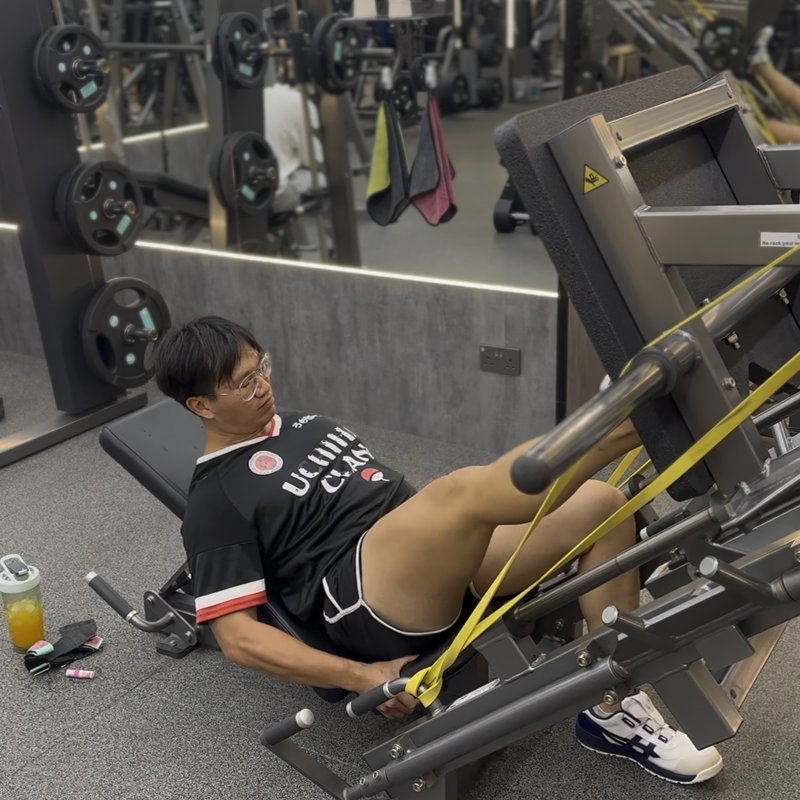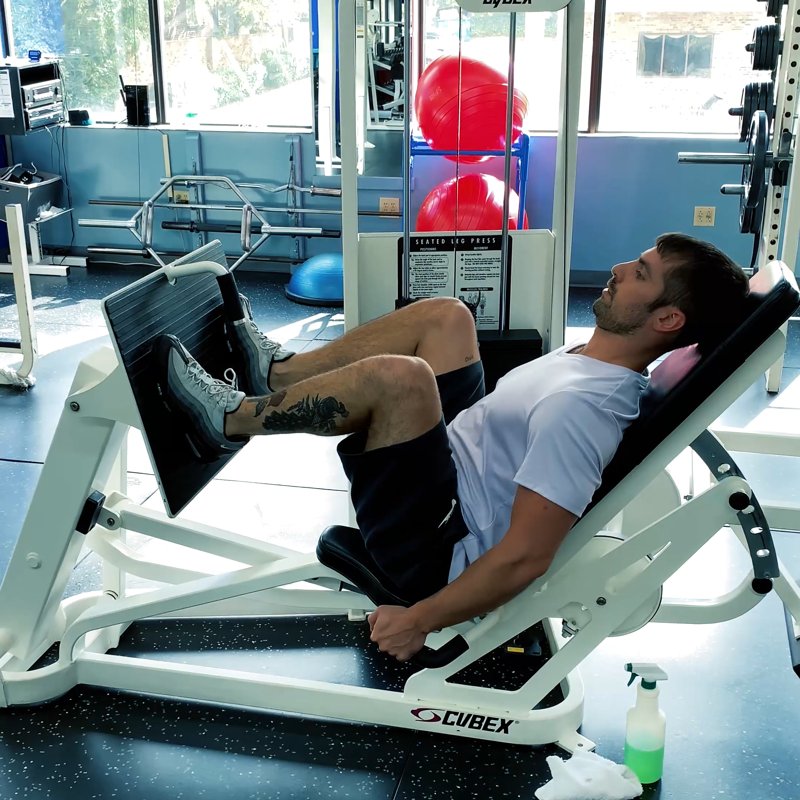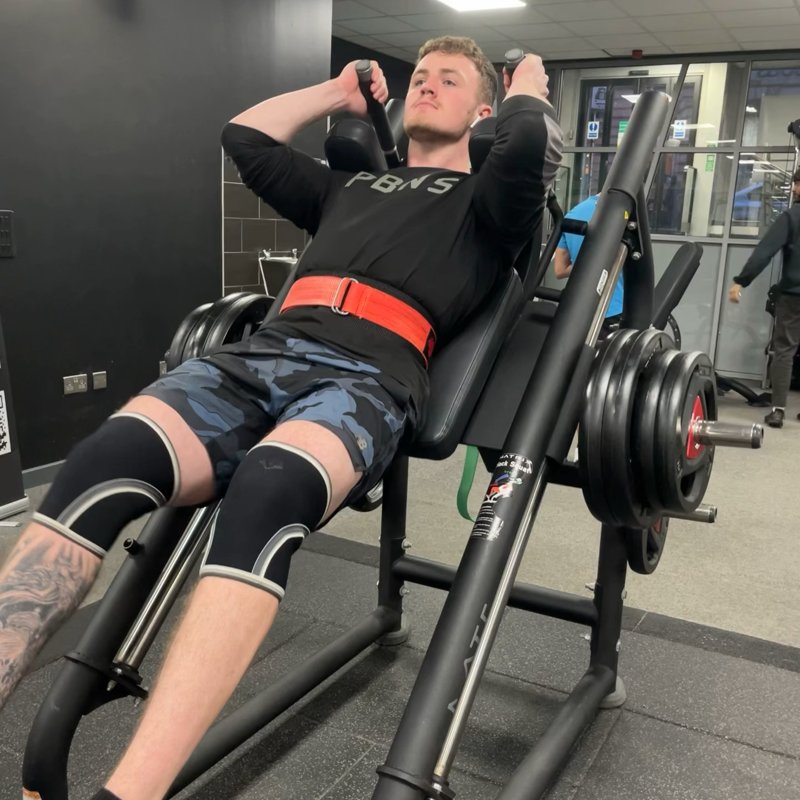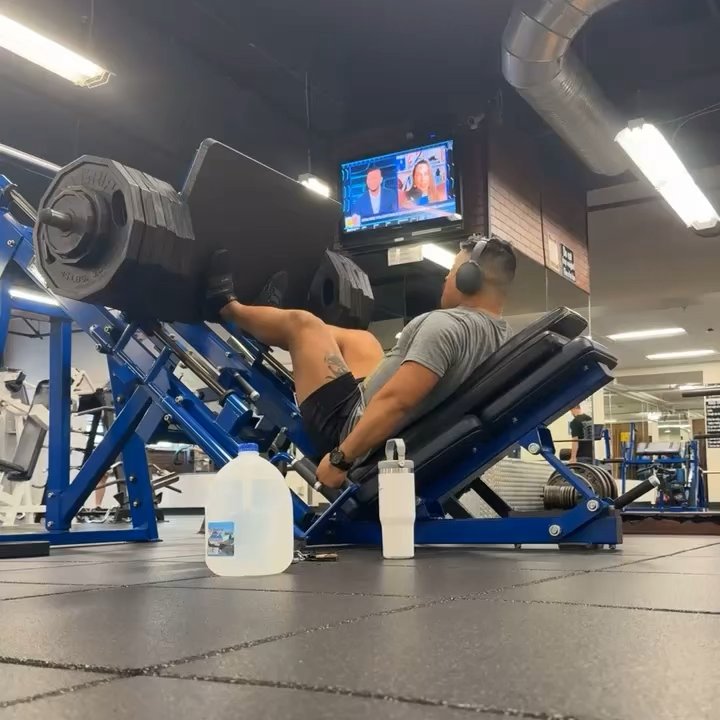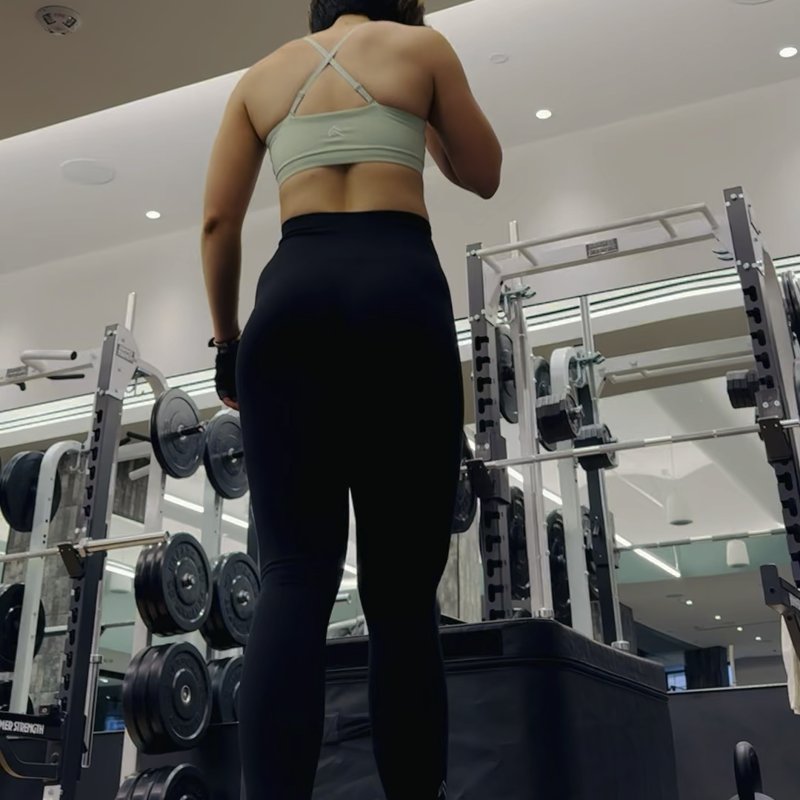Leg Press: The Ultimate Guide
The leg press is a fundamental lower body machine exercise that primarily targets the quadriceps, hamstrings, and glutes. This guide covers proper technique, variations, and programming strategies for maximizing leg development with minimal lower back stress.

Quick Facts
Key Benefit
Develops lower body strength and muscle mass with reduced lower back and core stabilization demands
Primary Muscles
Glutes, Hamstrings, Quadriceps
Secondary Muscles
Calves, Erector Spinae, Hip Adductors
Equipment
Machine
Difficulty
Beginner
Type
Compound, Strength, Hypertrophy
In This Guide
Ready to master the Leg Press?
Track your progress, see improvements over time, and build strength consistently.
Download GravitusThe Leg Press is a cornerstone exercise for developing lower body strength and size. This machine-based compound movement primarily targets the quadriceps, hamstrings, and glutes while also engaging the calves and adductors to varying degrees depending on foot placement. Unlike free-weight exercises such as squats, the leg press allows you to train your legs with substantial loads while minimizing stress on the lower back and reducing the need for core stabilization and technical proficiency. This makes it an excellent option for beginners learning lower body movement patterns, those with certain back issues, and advanced lifters looking to add training volume without excessive systemic fatigue. Available in several varieties including the 45-degree leg press, vertical leg press, and horizontal leg press, this versatile exercise can be adapted to various training goals through adjustments in foot positioning, range of motion, and loading parameters. Whether you're looking to build massive quads, increase overall leg strength, or rehabilitate after an injury, the leg press can be a valuable addition to your training program. This comprehensive guide covers proper technique, common mistakes to avoid, effective variations, and programming strategies to help you maximize your results with this powerful lower body exercise.
Why the Leg Press Is Worth Mastering
The leg press offers several distinct advantages that make it a valuable addition to any leg training program:
Heavy Loading Potential
Allows for substantial weight to be used safely, as the fixed movement path and back support minimize balance and stabilization demands.
Reduced Lower Back Stress
The supported back position removes much of the compressive loading on the spine that occurs during free-weight squatting movements.
Targeted Muscle Development
Various foot positions can be used to emphasize different muscle groups, allowing for precise targeting of specific areas of the lower body.
Proper Leg Press Form: Step-by-Step
Setup
- Adjust the seat position so your knees form approximately a 90-degree angle when your feet are on the platform.
- Sit in the machine and place your feet on the platform at about shoulder-width apart, with toes pointing slightly outward.
- Position your feet at the middle height of the platform, with your entire foot (heel to toe) making firm contact.
- Keep your back flat against the backrest, with head and shoulders firmly supported.
- Grasp the handles or sides of the seat for stability.
- Before unlocking the safety mechanism, brace your core to maintain a neutral spine position throughout the movement.
The Movement
- Release the safety mechanism and lower the platform by bending your knees, keeping your back firmly against the pad.
- Lower the weight in a controlled manner until your knees reach approximately a 90-degree angle (or your personal safe range of motion).
- Without bouncing at the bottom position, push through your entire foot (emphasizing mid-foot and heel) to extend your legs.
- Continue pushing until your legs are extended but avoid fully locking out your knees at the top position.
- Hold the extended position briefly, then slowly lower the platform back to the starting position while maintaining control.
- Repeat for the desired number of repetitions, re-engaging safety locks when finished.
Key Form Tips
Back Position
Keep your lower back, mid-back, and head firmly against the support pads throughout the entire movement.
Knee Tracking
Ensure your knees track in line with your toes, not caving inward or excessively pushing outward.
Foot Pressure
Distribute weight across your entire foot, with emphasis on the mid-foot and heel for optimal force production.
Range of Motion
Find a depth that challenges your muscles without compromising form or causing pain.
Breathing
Inhale during the lowering phase, exhale during the pushing phase.
Avoid Lockout
Keep a slight bend in the knees at the top position to maintain tension on the muscles and reduce knee stress.
Muscles Worked in the Leg Press
Primary Muscles
- quadriceps: The four muscles at the front of the thigh (rectus femoris, vastus lateralis, vastus medialis, vastus intermedius) that extend the knee during the pushing phase.
- hamstrings: The muscles at the back of the thigh that act as stabilizers during the leg press and are more engaged with deeper ranges of motion.
- glutes: The largest muscle in the buttocks region, which assists with hip extension during the pushing phase, especially with deeper ranges of motion.
Secondary Muscles
- hip adductors: The inner thigh muscles that help stabilize the legs during the movement, with increased involvement when using a wider stance.
- calves: The muscles of the lower leg that assist with knee extension and ankle stabilization during the leg press.
- erector spinae: The muscles along the spine work isometrically to maintain proper back position against the backrest.
Common Mistakes and How to Avoid Them
Lifting the hips off the seat
Raising your hips reduces leg involvement and can stress the lower back. Keep your entire back and hips firmly against the seat and backrest throughout the movement. If you need to lift off the seat to reach depth, the weight is too heavy or the range of motion is too deep for your current flexibility.
Placing feet too high on the platform
While a higher foot position can shift emphasis to the glutes and hamstrings, placing them too high can create excessive knee flexion and potential strain. Position your feet so that when you reach the bottom position, your shins are roughly parallel to the platform or at a slight angle.
Locking out the knees completely
Fully extending and locking the knees at the top of the movement can place harmful stress on the joint and momentarily removes tension from the muscles. Always maintain a slight bend in the knees at the top position to keep tension on the working muscles and protect joint health.
Using excessive range of motion
Going too deep can cause the lower back to round and lift off the pad, potentially leading to injury. Only go as deep as you can while maintaining proper form with your back flat against the backrest. Depth should be determined by individual anatomy and mobility, not arbitrary standards.
Leg Press Variations
Foot Position Variations
-
Wide Stance Leg Press
Placing feet wider than shoulder-width with toes pointed slightly outward increases activation of the inner thigh (adductors) and medial quadriceps, while slightly decreasing range of motion.
-
Narrow Stance Leg Press
Positioning feet closer together targets the outer quadriceps (vastus lateralis) more intensely and often allows for a greater range of motion for those with good mobility.
-

High Foot Position
Placing feet higher on the platform shifts emphasis to the posterior chain muscles (hamstrings and glutes) with less quadriceps involvement.
Advanced Variations
-
Single-Leg Press
Performing the exercise with one leg at a time highlights and addresses strength imbalances between sides while increasing the stabilization demands on the working leg.
-
Tempo Leg Press
Manipulating the speed of both concentric and eccentric phases (e.g., 3-second lowering, 1-second pause, 1-second press) increases time under tension for enhanced muscle growth stimulus.
-

Partial Range Overload
Using a heavier weight through a limited range of motion (typically the top half) to overload the muscles beyond what would be possible with full range movements.
FAQs About the Leg Press
Both exercises effectively build leg strength, but in different ways. Squats typically activate more total musculature, requiring core stabilization, balance, and coordination while training the body as an integrated unit. The leg press isolates the legs more completely, often allowing for heavier loads with less technical demand and reduced lower back stress. For optimal development, consider both exercises complementary rather than competitive—squats for overall athletic development and functional strength, leg press for additional leg-specific volume and hypertrophy with less systemic fatigue and technical constraints.
The ideal depth depends on your individual anatomy, mobility, and goals. The key principle is to go as deep as possible while maintaining proper form—specifically keeping your lower back flat against the backrest at all times. For most people, this means lowering until the knees reach approximately 90 degrees of flexion. Those with exceptional mobility might go slightly deeper, while others may need to use a more limited range of motion. Never sacrifice form for depth, as allowing your lower back to round under load significantly increases injury risk.
For balanced leg development, a moderate stance with feet shoulder-width apart and toes slightly turned out (about 15-30 degrees) is generally most effective. This neutral position engages all the major lower body muscles relatively evenly. That said, foot placement can be strategically varied to emphasize different muscle groups: higher foot placement shifts emphasis to hamstrings and glutes, lower placement emphasizes quadriceps, wider stance increases adductor involvement, and narrower stance targets the vastus lateralis more intensely. For comprehensive development, consider rotating between different foot positions throughout your training program.
Video Demonstrations

Log in to watch video demonstrations
Login to Watch3 video demonstrations available
Find more video demonstrations in the Gravitus app
Tips from the Community
-

Keep your legs slightly farther than shoulder width apart. Inhale while lowering the weight, and exhale while pressing the weight with force.
-

Do not lift your ass off the seat.
-

Never lock your knees!
-

It’s cool to lock your knees if you don’t hyper extend. Just use a reasonable amount of weight and a full range of motion with a pause at the bottom.
-

Never lock your legs out!! Seen plenty of videos of people’s legs snapping backwards due to this. Some people’s resting lock out is naturally hyper extended.. enough wait and your legs will bend at the knee cap but the wrong way
Track your progress with Gravitus
Download Gravitus to log your workouts, track your progress, and join a community of fitness enthusiasts.

Helpful Resources
One Rep Max Calculator
Find your one rep max for any exercise without maximal testing. Essential for developing effective strength training programs.
Calculate 1RMWorkout Programs
Follow structured workout programs created by fitness professionals to maximize your strength and muscle gains.
View Programs